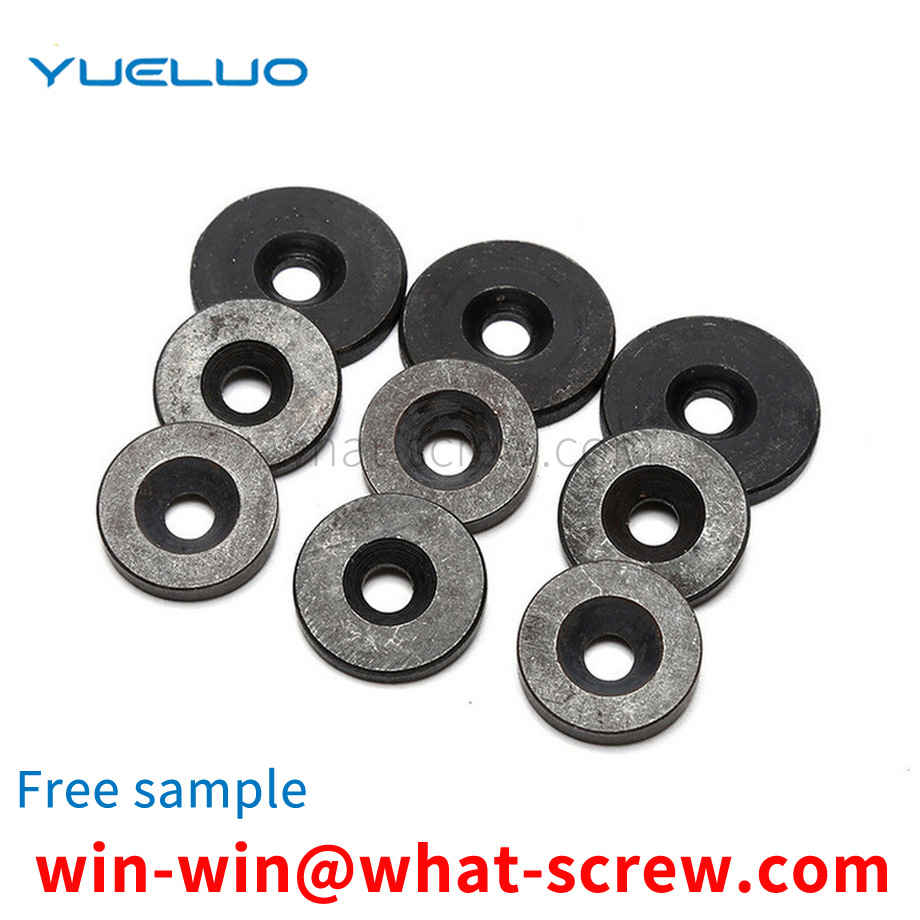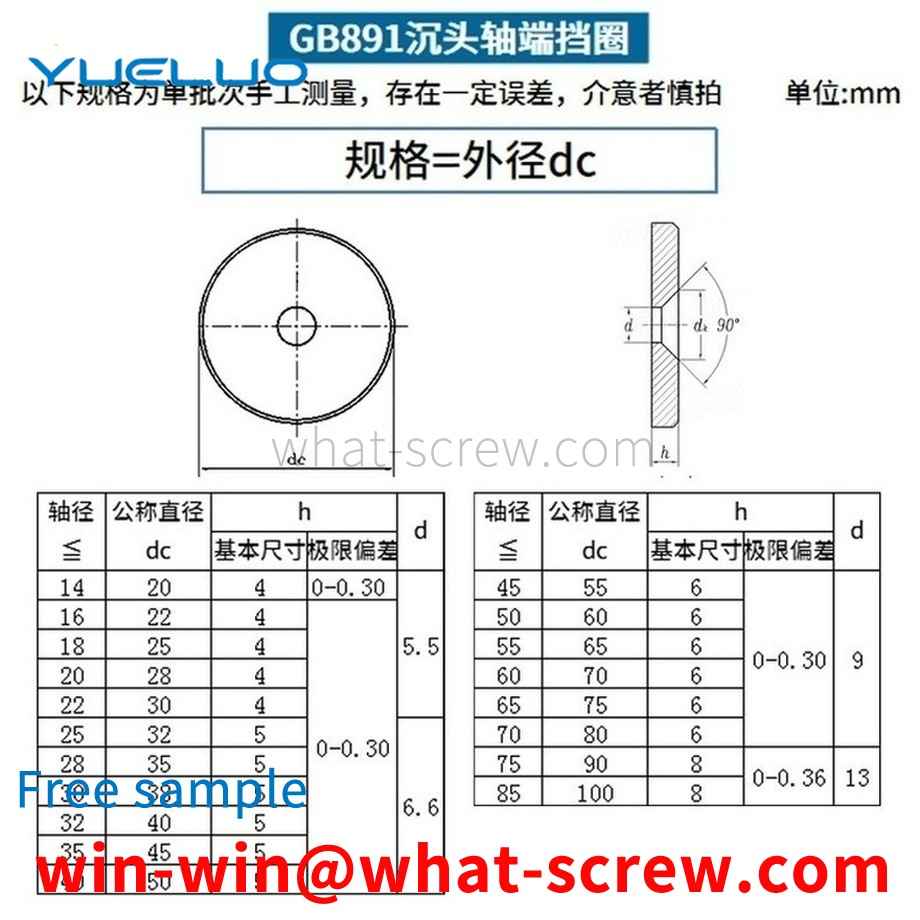Common types of common screws All kinds of common screws (20 pieces) a. Slotted: a word ( Minus ) b. Phillips: cross ( Plus ) c. Phil-Slot: a word / cross d. Hex Socket: hexagon socket e. One Way: One-way (can only be locked in, not out) A-4: Head Code/ head shape. a. Flat: Flat head (after locking, the top is flush with the work piece) b. Oval: salad head, O head, countersunk head screw unit of measure screw unit of measurec. Round: round headd. Pan: round flat heade. Truss: large round flat headf. Hex: hexagon head. A-5: Finish Code/Appearance treatment. Metric Self-tapping screw: Mark Tapping Type directly behind the product name. Ex: M3 x 6 –PPB, Tapping Type: M3 self-tapping screw, 6mm long, cross, round flat head, black plated. Generally, it is determined by product type or mark. For Sheet Metal or plastic parts. *Pitch = Threads per inch
The pressure riveting nut, also known as the self-tightening nut, is a kind of nut applied to thin plates or sheet metal parts. To facilitate the installation of other parts on the printed circuit board. The conventional process is to design prefabricated holes on the printed circuit board in advance, and squeeze the rivet nut into the board through pressure, so that the periphery of the hole is plastically deformed, so that the rivet nut is firmly fixed on the circuit board. In important positions, the use environment of pressure riveting nuts is relatively harsh. In display products, due to space constraints, pressure riveting screws are used a lot. The riveting quality of pressure riveting screws has a direct impact on the reliability of the system. The riveting process is correct. The key technology of using rivet nuts.
Anchor bolts are also known as stiffened anchor plate anchor bolts, welded anchor bolts, anchor claw anchor bolts, rib plate anchor bolts, anchor bolts, anchor screws, anchor wires, etc. It is specially designed to be buried in the concrete foundation and used as the base for fixing various machines and equipment. Figure 7 anchor bolts are the most commonly used anchor bolts. It is generally made of Q235 steel, with high strength using Q345B or 16Mn material, and also using 40Cr material to process 8.8-strength products, and occasionally using secondary or tertiary rebar. Anchor bolts are divided into wool, thick rod and thin rod. The wool material is the raw material steel, which is directly processed from round steel or wire without modification; thick rods or called A-type, thin rods or B-type, are processed from steel modified into the corresponding required rod diameter. Welded anchor bolts are made of single-headed bolts welded with stiffened iron plates. Its anti-pulling ability is strong. According to the different conditions of use, it can reach 3.6, 4.8, 6.8, 8.8 and other grades respectively. The tensile capacity of 3.6 grade 7-shaped anchor bolts is the tensile capacity of the steel itself. The tensile strength of anchor bolts directly processed from Q345B or 16Mn raw materials can reach a tensile strength of 5.8. The tensile strength of grades 4.8, 5.8, 6.8 and 8.8 refer to the provisions on mechanical properties in GB/T3098.1.
In the manufacture of fasteners, the correct selection of fastener materials is an important part, because the performance of fasteners is closely related to its materials. If the material is improperly or incorrectly selected, the performance may not meet the requirements, the service life may be shortened, or even accidents or processing difficulties may occur, and the manufacturing cost will be high. Therefore, the selection of fastener materials is a very important link. Cold heading steel is a steel for fasteners with high interchangeability produced by cold heading forming process. Because it is formed by metal plastic processing at room temperature, each part has a large amount of deformation and a high deformation speed. Therefore, the performance requirements of cold heading steel raw materials are very strict. On the basis of long-term production practice and user research, combined with GB/T6478-2001 Technical Conditions for Cold Heading and Cold Extrusion Steel GB/T699-1999 High-Quality Carbon Structural Steel and target JISG3507-1991 Cold Heading Characteristics of Carbon Steel Wire Rod for Steel, taking the material requirements of grade 8.8 and grade 9.8 bolts and screws as an example, the determination of various chemical elements. If the C content is too high, the cold formability will be reduced; if it is too low, the mechanical properties of the parts cannot be met, so it is set at 0.25% - 0.55%. Mn can improve the permeability of steel, but adding too much will strengthen the matrix structure and affect the cold forming performance; when the part is quenched and tempered, it has the tendency to promote the growth of austenite grains, so it should be appropriately improved on the basis of international standards. 0.45 % - 0.80 %. Si can strengthen the ferrite and reduce the cold formability. SP is an impurity element, and their existence will cause segregation along the grain boundary, resulting in the embrittlement of the grain boundary and damage to the mechanical properties of the steel. It should be reduced as much as possible. B. The maximum value of boron content is 0.005%, because although boron element can significantly improve the permeability of steel, it will also increase the brittleness of steel. Excessive boron content is very unfavorable for workpieces such as bolts, screws and studs that require good comprehensive mechanical properties.
The main technical problem to be solved by Guangdong Yueluo Hardware Industry Co., Ltd. is to provide a rivet that can choose the breaking point, which can not only solve the bad effect caused by random shearing, but also can keep the mandrel in the hole to increase the strength after riveting, and also When the same type of rivet is riveted with different riveting thickness, changing the mandrel breakpoint can always make the mandrel breakpoint break at the required place, improve the tensile and shear strength of the rivet, increase the riveting quality of the product, and prolong the service life of the rivet.
We have many years of experience in the production and sales of screws, nuts, flat washers, etc. The main products are: flat round head pan head screws, round head Torx screws, 4 extension screws, plastic hexagonal nuts and other products, we can provide you with suitable products for you. Fastener Solutions.



















 Service Hotline
Service Hotline




